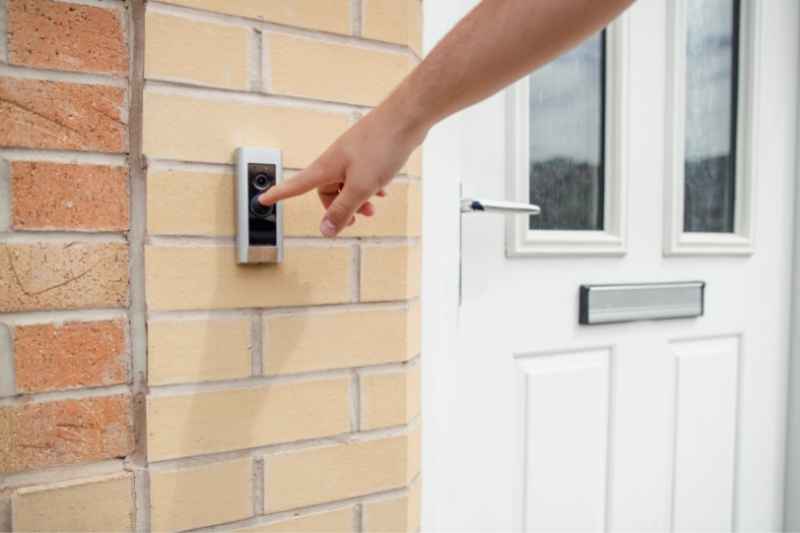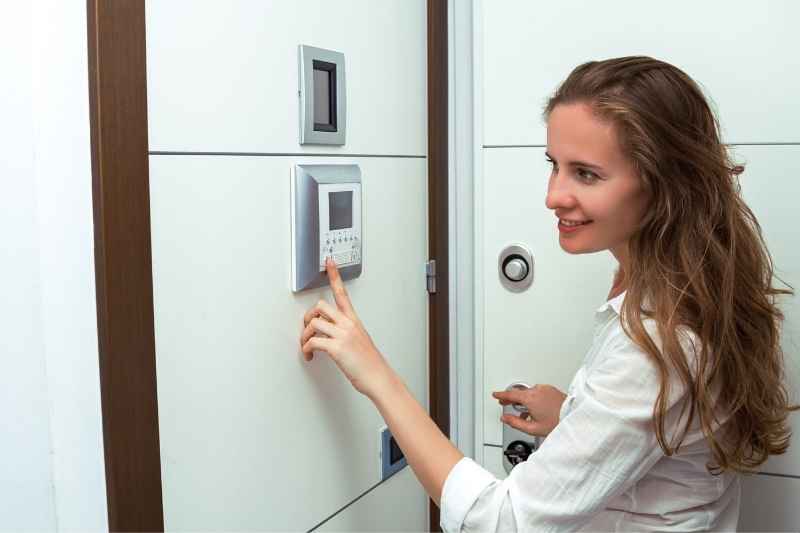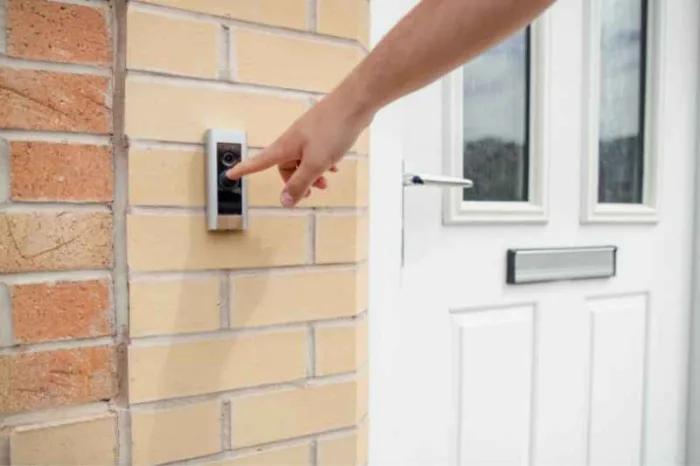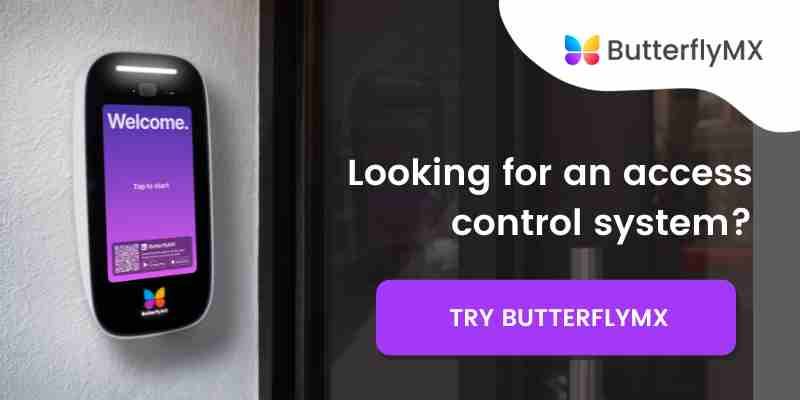Key takeaways
- Doorbell phone systems are a humble effort to update and digitize doorbells. But at the end of the day, they lack the features and capabilities that modern tenants crave.
- Don’t waste your time and money on doorbell phones, which require constant maintenance and replacement.
- Instead, invest in robust and smart access control devices that will withstand the test of time.

One of your top priorities as a property owner and manager is ensuring that tenants can easily let visitors in — while keeping intruders out. Today, there are many access control systems to choose from, both old and new. One of the solutions you may have come across is a doorbell phone.
Door phones with doorbells are a type of entry system that have been around for decades. Aside from notifying tenants of a visitor’s arrival, this aging device fails to meet the needs of modern tenants. Read on to learn more about doorbell phones, how they work, their limitations, and how to find a better alternative.
In this post, we’ll cover:
- What is a doorbell phone?
- How does a doorbell phone work?
- Limitations of doorbell phone systems
- Replacing your property’s doorbell phone
What is a doorbell phone?
A doorbell phone is a device that allows a visitor to alert a building tenant of their arrival. What sets this system apart from other doorbells is its phone component.
You might’ve wondered, is there a doorbell that notifies your phone? Yes, there is. Doorbell phone systems place calls to either an in-unit phone or the tenant’s cell phone. So, after the visitor rings the doorbell, the tenant gets alerted by a phone call.
Traditionally, doorbell phones required you to install an in-unit device in every residence or office suite. Some older properties still use those kinds of doorbell phones to this day. But nowadays, companies like Amazon have released doorbell phone systems powered by a smartphone.
Modern devices also have a video door phone component that allows tenants to video chat with their guests before opening the door. For example, Amazon’s Ring doorbell device has a micro video camera that lets tenants see who’s at the door.

Types of doorbell phones
With technology evolving every day, many different types of doorbell phone systems exist today. Over the years, the term has come to encompass a wide variety of entry systems.
The three most common types of doorbell phone systems are:
1. Video doorbell phone
Generally speaking, video doorbell phone systems are devices that enable tenants to communicate with and see their guests. The system’s in-unit door phone connects to outdoor hardware installed at the property’s entrance.
A video door phone’s most important feature is allowing a tenant to visually confirm a visitor’s identity before letting them in.
Video door phones use different kinds of network connections:
- Wired vs. wireless: Unlike traditional systems that require wired in-unit devices, wireless video door phones communicate with the entrance hardware using wireless technology. The most common type is a WiFi video door phone, which uses the building’s internet connection to wirelessly call the tenant when a visitor dials their unit. Additionally, the tenant can have either a one- or two-way video call with the visitor on their smartphone.
- IP-based: IP video door phones use the Internet Protocol to transfer audio and video data between the entry device and in-unit door phones. They require minimum wiring — all you need is to connect both devices to a Power over Ethernet cable, which supplies both the AC power and internet connection. Some systems specifically use Session Initiation Protocol (SIP) to transfer data between devices.
2. Video doorbell phone intercom system
A video doorbell phone with an intercom system consists of a camera-equipped intercom at the building’s entrance and video door phones inside every unit.
This is perhaps the most expensive door phone system since it requires each door phone to be wired to the entryway doorbell hardware. You also need to pay for telephone service to enable calls between visitors and tenants.
3. Mobile doorbell phone
Since most Americans own smartphones, newer doorbell phones are compatible with tenants’ mobile devices. Wireless door phones come with a smartphone app that notifies the tenant when the guest rings the doorbell.
Some systems have smartphone doorbell cameras that allow tenants to see live footage of the front entrance. However, these systems don’t have a way for guests to see the tenants.
How does a doorbell phone work?
A doorbell phone system works when a visitor presses the doorbell, which rings the tenant’s in-unit device or their cell phone. After the tenant verifies the guest’s identity, they come to the front door to let the guest in.
Doorbell phones have two components:
- Base station (doorbell): The doorbell is the base station installed at the entryway of the building. Typically, doorbell systems are designed for single-family homes, so they have only one button for visitors to press to alert the resident of their presence. On rare occasions, there are doorbells specifically designed for multi-tenant buildings, which have multiple call buttons. In that case, the visitor presses the button that corresponds with the resident they’re visiting.
- Substations (phones): Either in-unit door phones or tenants’ smartphones can be the substations. Tenants use these devices to answer visitors’ calls. In some cases, the in-unit door phone has a camera that broadcasts live footage of the tenant to the base station for visitors to view.
Lastly, some (but not all) doorbell phone systems connect the doorbell to a door release mechanism. This way, the doorbell system sends signals to the electric lock to unlock the door when the tenant presses a button on the substation. As a result, tenants can remotely grant access to their visitors without physically opening the door for them.
Watch how ButterflyMX works:
How do I connect my phone to my doorbell?
You connect a doorbell system to your smartphone by downloading the manufacturer’s mobile app. Depending on the doorbell model, instructions for connecting the doorbell to a smartphone differ, but you will likely have to pair the app with your doorbell system. Alternatively, your property manager may assign you access credentials.
In general, both the doorbell phone and your smartphone must have an internet connection. And in some cases, your smartphone has to be on the same internet network as the doorbell to establish a connection.
How do you answer the doorbell phone?
When a visitor presses the doorbell button, it alerts the tenant’s smartphone or in-unit device. Then, the tenant answers the doorbell call by tapping on the device’s screen, which allows the tenant to communicate with the visitor. Some doorbell systems also show live video footage of the visitor.

Limitations of doorbell phone systems
Although smart video door phone systems are certainly an upgrade from traditional doorbells, they still have shortcomings.
While these systems are reasonably easy and affordable to install, the low price speaks for itself. Specifically, they can’t provide robust security or convenient features.
The major limitations of doorbell phone systems are:
- Most devices run on batteries. Many doorbell phone systems run on rechargeable or replaceable batteries. So, you must charge or replace the batteries whenever they’re running low. As a result, your building’s entrance might be without a doorbell at times. This means there’s no way for visitors to announce their arrival.
- Not all doorbell phones have door release mechanisms. Since most doorbell phone systems aren’t hardwired to the door, there’s no way for tenants to open the door for visitors remotely. Instead, tenants need to physically come to the front door to open it.
- They offer lackluster visitor management solutions. Doorbell phone systems don’t provide a way for visitors to let themselves in when the tenant isn’t home. Unlike smart intercom systems, doorbells don’t support Visitor Passes or guest PIN codes. This means that if the tenant isn’t home or in the office, their guests are stranded outside.
- The entry device can easily be stolen or broken. Since most doorbell phone systems aren’t hardwired into your door or entryway, they become susceptible to theft or vandalism. All a criminal would have to do is detach the doorbell device from its mount and walk away with it.
Replace your building’s doorbell phone
If you own or manage a multi-tenant property, using a doorbell phone as your entry system just won’t cut it. Ultimately, doorbell phones are meant for single-family homes and don’t offer features and security measures needed at multifamily properties.
Luckily, there are better options.
Replace your property’s doorbell phone device with a cloud-based smart access control system. These systems are rich in the convenience and security-focused features necessary at any multi-tenant building. Best of all, smart access control systems are highly customizable, so you’ll find the perfect solution for your property’s needs.
Replace doorbell phones with smart access control devices such as:
- Smartphone-based video intercom: Install a video intercom to control access at the front door or gate. Choose a system with a highly-rated mobile app so tenants can grant access to themselves and their visitors from their phones. Plus, when visitors request access, the intercom places a two-way video call directly to the tenant’s smartphone.
- Keypads with cameras: Place smart keypads at amenity spaces, supply closets, office suites, and other interior entrances. That way, authorized tenants have secure access to shared spaces within the building. The keypad’s camera takes a photo each time someone enters the room, so you can feel confident that only authorized users enter those rooms.
- Elevator controls: If your building has elevators, you may want to control access to those too. Elevator controls ensure that only authorized visitors can access elevators while only having access to the floor they’re permitted to visit.
Why smartphone-based access control systems are better than doorbell phones
Essentially, doorbell phones are minor upgrades from traditional doorbells. While they may work for single-family homes — where someone is always home to open the door — they’re not fit for multifamily or commercial properties.
When you install a smartphone-based access control system at your property, it’ll significantly elevate the access experience. Everyone will enjoy a host of versatile features that improve how they work, live, and play.
Choose an access control system with these features:
- Delivery passes: Nowadays, tenants have packages and food delivered to their homes or offices at astonishing rates. Delivery passes are single-use access PINs that couriers use to place deliveries inside the building securely.
- Multiple ways to open the door: The modern tenant expects to open the door from their smartphone or other devices. Keys are becoming artifacts of the past. So, choose a system that supports multiple ways to open the door, such as swiping on smartphones or using voice commands.
- Visitor Passes: Today, tenants welcome many visitors — family and friends, on-demand service providers, and business clients — to their buildings every day. With Visitor Passes, trusted guests can let themselves in, even when the tenant isn’t there.







